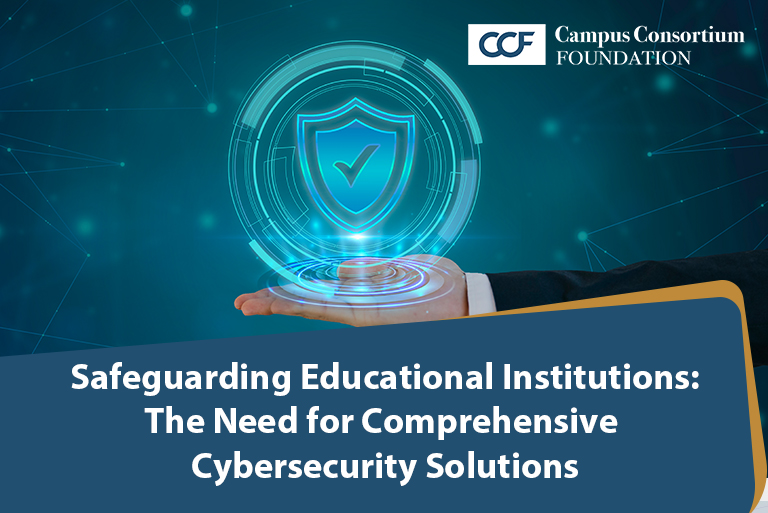In today’s tech-driven education landscape, schools, colleges, and universities increasingly rely on digital platforms for everything from instruction to administrative operations. However, this dependency on technology brings with it an urgent need for comprehensive cybersecurity measures. Educational institutions are becoming prime targets for cyberattacks, putting sensitive student and staff data at significant risk. A single data breach can not only disrupt learning but also harm an institution’s reputation and lead to expensive fines for failing to comply with regulations such as GLBA and GDPR. For these reasons, educational institutions must adopt robust and comprehensive cybersecurity strategies.
Managed Detection and Response (MDR): Real-Time Protection for Schools
In the complex digital environment of educational institutions, where students and staff access networks from various devices and locations, implementing Managed Detection and Response (MDR) is a key element of any cybersecurity strategy. MDR solutions provide 24/7 real-time monitoring, quickly detecting and responding to threats before they can cause harm. With the rise of sophisticated cyberattacks, such measures are critical to ensuring uninterrupted protection across campus networks. MDR helps identify and mitigate vulnerabilities, making it far more difficult for malicious actors to exploit weaknesses.
By securing sensitive student records, preventing breaches, and maintaining the smooth operation of educational institutions, MDR plays a pivotal role in modern campus security.
Compliance with Regulations: Navigating FERPA, GDPR, and More.
Compliance with privacy and data protection regulations is a fundamental requirement for educational institutions. In the U.S., educational institutions compliances like General Data Protection Regulation (GDPR), and more sets rigorous standards for data handling and protection. Failing to comply with these regulations can lead to severe fines, legal action, and reputational damage.
Given the complexity of these regulatory frameworks, having a dedicated compliance service is essential. These services help institutions stay up to date with the latest regulations, conduct regular audits, and ensure that policies are properly aligned with evolving standards. Beyond avoiding penalties, compliance efforts also build trust among students, parents, and staff, showing that their data is handled with care and responsibility.
Threat Intelligence: Staying One Step Ahead of Cybercriminals
With cyber threats constantly evolving, educational institutions need access to real-time intelligence about emerging risks. Threat intelligence offers valuable insights into the latest vulnerabilities and attack vectors, allowing institutions to proactively strengthen their defenses and fix potential weak points before they can be exploited.
By leveraging threat intelligence, educational organizations can make informed security decisions and remain prepared for even the most advanced cyber threats. This capability is essential to maintaining a proactive stance on cybersecurity rather than reacting after an attack has already occurred.
Incident Response: Minimizing Downtime and Disruption
Despite the best efforts to defend against cyber threats, breaches and incidents can still happen. Having a strong Incident Response plan in place ensures that when a breach occurs, the institution can contain the attack, recover lost data, and restore operations as quickly as possible.
A well-executed incident response strategy minimizes the impact of cyberattacks, reducing downtime and limiting disruptions for students, faculty, and staff. Whether it’s dealing with ransomware or a significant data breach, being prepared can mean the difference between a minor hiccup and a major operational crisis.
Real-World Example: Lessons from a Recent Cyberattack
In 2023, a major university suffered a severe cyberattack that compromised the personal data of over 500,000 students and faculty members. The breach exploited a vulnerability in the university’s outdated system, resulting in weeks of disruption as the institution scrambled to recover. This attack could have been avoided with proper MDR solutions and a more robust incident response plan. Proactive measures like these would have enabled the university to avoid the damaging financial, operational, and reputational consequences.
Conclusion: Take Action to Protect Your Institution
As cyber threats continue to evolve, educational institutions must prioritize cybersecurity measures to protect their sensitive data, avoid costly regulatory fines, and ensure the smooth, uninterrupted functioning of their operations. From MDR to compliance services and incident response, adopting comprehensive cybersecurity solutions is critical to staying ahead of potential threats.
Ready to secure your campus? Contact the Campus Consortium Foundation today to explore how cybersecurity solutions can help protect your institution from cyberattacks. Together, we can safeguard the future of education.




